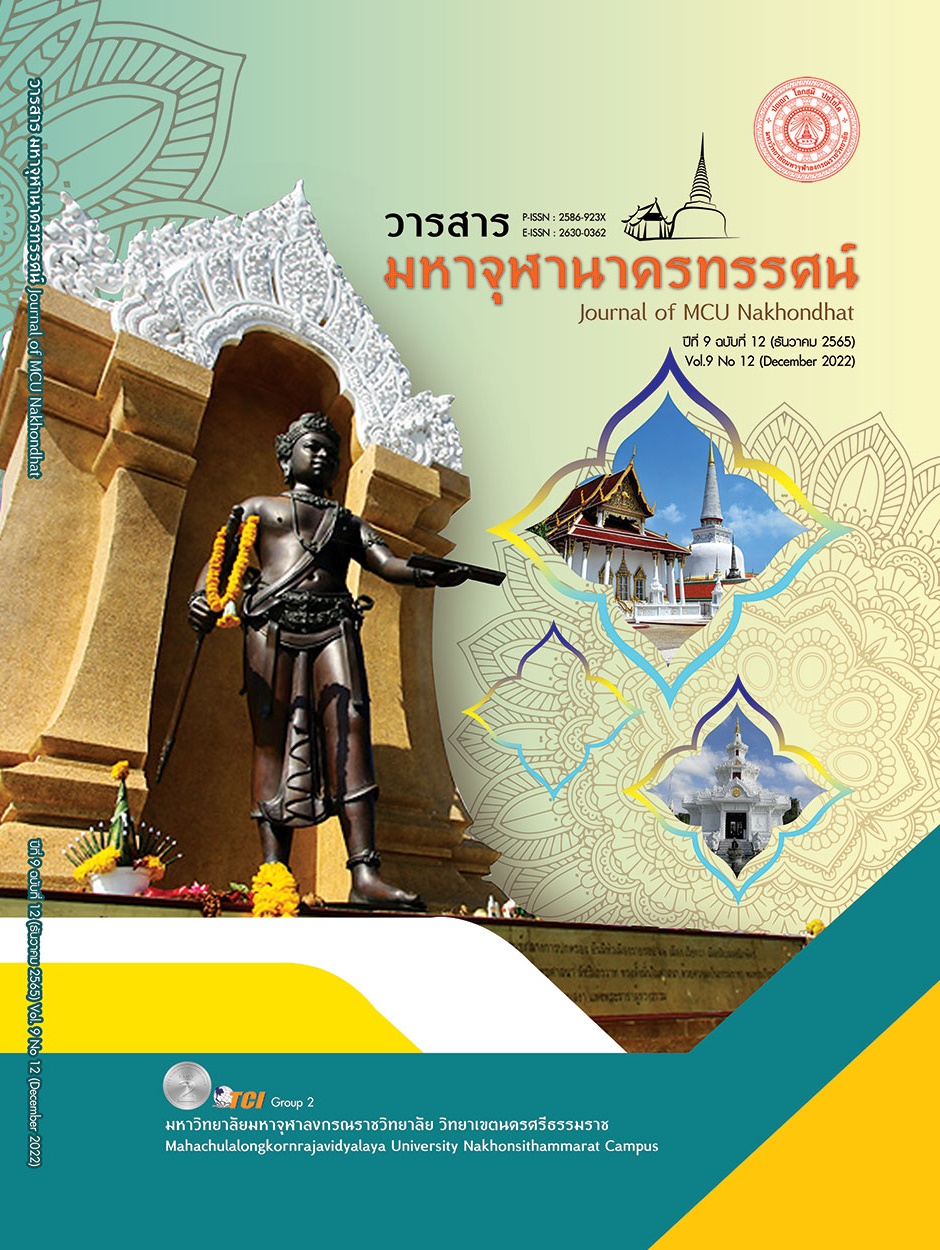THE USE OF BILINGUAL FOLKTALES TO ENHANCE ENGLISH VOCABULARY KNOWLEDGE OF PRIMARY 3 STUDENTS
Main Article Content
Abstract
The objectives of this research were to 1) develop bilingual folktales lessons to meet the efficiency criterion of 70/70, and 2) study students’ vocabulary knowledge achievement before and after using the lessons. A sample of 12 primary 3 students at Nong Rad Wittaya School in academic year 2020 was obtained by using purposive sampling. The instruments consisted of a pre-test, a post-test, and 4 bilingual folktale-based lessons. Each lesson included 1) an illustrated bilingual folktale, based on the local literature orally narrated by community scholars, 2) 10 words in the vocabulary part presented with their related pictures, and 3) vocabulary exercises. The words were selected using basic English vocabulary for primary school students according to the English Language Institute, Office of the Basic Education Commission. The lessons were employed through three stages of storytelling activities including pre listening and reading, while listening and reading, and post listening and reading. These lessons, with the efficiency criterion of 70/70, were also validated by experts for their content accuracy and suitability which were found at moderate levels. The pre- and the post-tests had the IOC ranged from 0.67 and 1.00. Mean and standard deviation were used to analyze the data on students’ vocabulary knowledge before and after the lessons. The findings showed that 1) the bilingual folktales lessons had the efficiency level of 84.67/79.58 which exceeded the criteria, and 2) the students’ English vocabulary knowledge increased after implementing the bilingual folktale-based lessons. Before using the lessons, the pre-test mean score of students’ vocabulary knowledge was 12.50 (S.D. = 4.01) and their post-test mean score was 15.92 (S.D. = 2.68).
Article Details

This work is licensed under a Creative Commons Attribution-NonCommercial-NoDerivatives 4.0 International License.
References
จินตนา ฉัตรบูรภานันท์ และคณะ. (2556). การวิเคราะห์คำศัพท์ที่ปรากฏในเอกสารประกอบการสอนปรับพื้นฐานวิชาภาษาอังกฤษมหาวิทยาลัยเทคโลโลยีราชมงคลรัตนโกสินทร์. ใน รายงานการวิจัย. มหาวิทยาลัยเทคโลโลยีราชมงคลรัตนโกสินทร์.
ชื่นจิตร ว่องวชิราพาณิชย์ และเฉลิมชัย วิโรจน์วรรณ. (2556). ผลสัมฤทธิ์ทางการเรียนภาษาอังกฤษเพื่อการสื่อสารโดยใช้ภาพประกอบการสอน ของนักเรียนระดับชั้นประกาศนียบัตรวิชาชีพ วิทยาลัยเทคโนโลยีสยามบริหารธุรกิจนนทบุรี. วารสารวิชาการมหาวิทยาลัยนอร์ทกรุงเทพ, 2 (1), 17-22.
ดลวรรณ พวงวิภาต. (2554). ผลการเรียนรู้และความคงทนเรื่องคำศัพท์ภาษาอังกฤษจากการเรียนด้วยหนังสือนิทานอิเล็กทรอนิกส์ระดับชั้นประถมศึกษาปีที่ 5. ใน วิทยานิพนธ์ศึกษาศาสตรมหาบัณฑิต สาขาวิชาเทคโนโลยีการศึกษา. มหาวิทยาลัยศิลปากร.
ดารินทร อินทับทิม. (2564). รูปแบบชุมชนการเรียนรู้ทางวิชาชีพด้วยนิทานพื้นบ้าน 2 ภาษาของกลุ่มครูผู้สอนสาระภาษาไทยและภาษาอังกฤษชั้นประถมศึกษา กลุ่มเมืองพะเยา 1. วารสารมนุษยศาสตร์และสังคมศาสตร์ มหาวิทยาลัยพะเยา, 9(1), 29-55.
ปวีณา บุตรวงค์. (2558). ผลการเรียนรูปและความคงทนการจําคําศัพท์ของนักเรียนชั้นมัธยมศึกษาปี่ที่ 2 โดยใช้กลวิธีลินซ์รวมกับเทคนิคเพื่อนคูคิด. วิทยาการวิจัยและวิทยาการปริญญา, 13(2), 45-56.
ผณินทรา ธีรานนท์ และคณะ. (2564). โมเดลนิทานเพื่อสอนภาษาอังกฤษผ่านการบูรณาการการบริหารโครงการและการทำวิจัย: จากทฤษฎีสู่การปฏิบัติ. วารสารพัฒนาการเรียนการสอน มหาวิทยาลัยรังสิต, 15(1), 138-150.
พรรณนที โชติพงศ์. (2552). การใช้กิจกรรมประกอบจังหวะเพื่อพัฒนาความรู้ด้านคาศัพท์และความคงทนในการเรียนรู้คาศัพท์ภาษาอังกฤษของนักเรียนชั้นประถมศึกษาปีที่ 4. ใน วิทยานิพนธ์ศิลปศาสตรมหาบัณฑิต สาขาวิชาการสอนภาษาอังกฤษในฐานะภาษาต่างประเทศ. มหาวิทยาลัยศรีนครินทรวิโรฒ.
เพ็ญนภา คล้ายสิงโต และคณะ. (2560). การพัฒนาทักษะการอ่านออกเสียงและการเขียนเชิงวิเคราะห์ภาษาไทยผ่านนิทานของนักเรียนโรงเรียนตำรวจตระเวนชายแดนเบ็ตตี้ดูเมน. วารสารมนุษยศาสตร์วิชาการ, 24(2), 116-138.
ศุภลักษณ์ วัฒนาเฉลิมยศ. (2554). การพัฒนานิทานมัลติมีเดียเพื่อเสริมการอ่านภาษาอังกฤษด้วยตนเองที่มีการให้ความหมายของคำศัพท์ 3 รูปแบบ สำหรับนักเรียนชั้นประถมศึกษาปีที่ 4. ใน วิทยานิพนธ์การศึกษามหาบัณฑิต สาขาวิชาเทคโนโลยีการศึกษา. มหาวิทยาลัยศรีนครินทรวิโรฒ.
สถาบันภาษาอังกฤษ สำนักงานคณะกรรมการการการศึกษาขั้นพื้นฐาน กระทรวงศึกษาธิการ. (2559). คำศัพท์ภาษาอังกฤษพื้นฐาน ระดับชั้นประถมศึกษา. เรียกใช้เมื่อ 10 มีนาคม 2563 จาก https://www.mdh.go.th/news_file/p75850761016.pdf
สุธาสินี ทีฆะบุตร และ รินทร์ ชีพอารนัย. (2561). ผลการใช้กิจกรรมนิทานภาษาอังกฤษที่มีต่อความสามารถในการพูดของนักเรียนระดับประถมศึกษาปีที่ 6 โรงเรียนนาคประสิทธิ์ จังหวัดนครปฐม. Veridian E-Journal, Silpakorn University, 11(2), 968-981.
Gomez, M. B. (2010). How to use tales for the teaching of vocabulary and grammar in a primary education English class. RESLA, 23(2010), 31–52.
Isbell, R. et al. (2004). The effects of storytelling and story reading on the oral language complexity and story comprehension of young children. Early Childhood Education Journal, 32(3), 157-163.
Kalantari, F. & Hashemian, M. (2015). A story-telling approach to teaching English to young EFL Iranian learners. Journal of English Language Teaching, 9(1), 221-234.
Soleimani, H. & Akbari, M. (2013). The effect of storytelling on children's learning English vocabulary: A case in Iran. International Research Journal of Applied and Basic Sciences, 4(11), 4005-4014.


